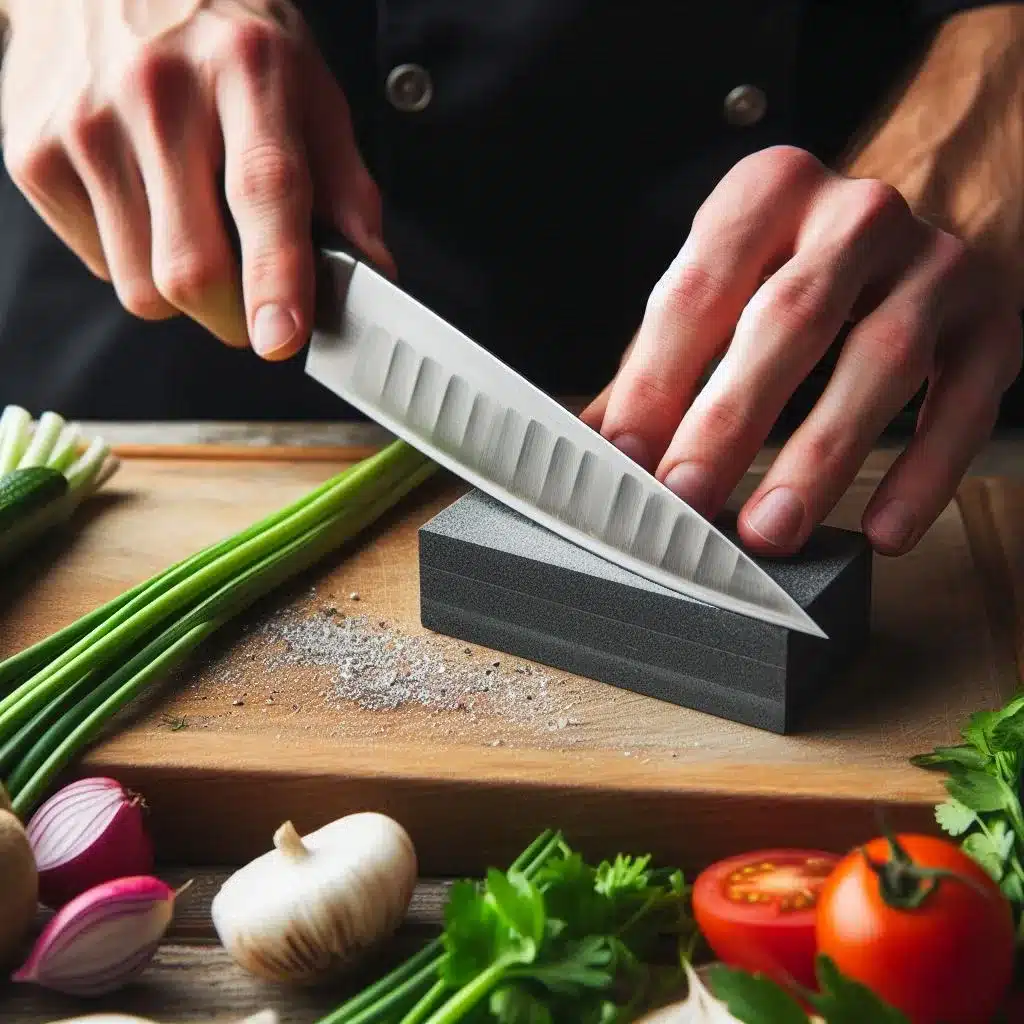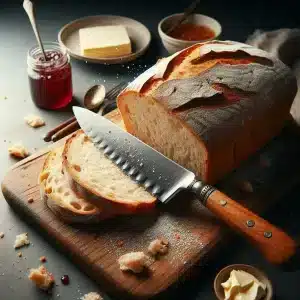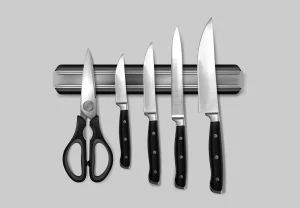Sharpening a knife is essential for both safety and performance. A dull knife not only makes cutting tasks more difficult but also increases the likelihood of accidents, as you need more force to cut, which can lead to slips and injuries. Whether you’re a chef, a home cook, or an outdoor enthusiast, learning how to properly sharpen a knife will extend the life of your blade and improve your cutting efficiency. The process of sharpening is more than just making the blade cut better—it’s about maintaining the integrity of the edge over time.
Different Tools for Sharpening Knives
To sharpen a knife properly, you need the right tools. Here are some common methods and tools used to sharpen knives:
Whetstone (Sharpening Stone)
A whetstone is a rectangular stone with different grit levels used to sharpen knives manually. It’s one of the most traditional and effective methods. Whetstones come in various grits; lower grits (like 1000 or below) are for reshaping a dull edge, while higher grits (3000 and above) polish and refine the edge. This method requires a bit of practice to master but provides excellent control over the sharpening process.
Honing Rod
Often mistaken for a sharpener, a honing rod is used to realign the blade’s edge rather than sharpen it. Honing should be done regularly to maintain the sharpness between major sharpening sessions. This tool helps to correct the small bends and misalignments that occur during regular use of the knife.
Electric Sharpeners
For those looking for a quick and easy way to sharpen their knives, electric sharpeners are a convenient option. These machines automatically grind the blade to the right angle and can quickly bring back an edge. However, it’s essential to use them correctly to avoid removing too much metal from the blade.
Knife Sharpening Systems
Sharpening systems are kits that allow you to sharpen a knife at a consistent angle. They often include guides for the blade and various stones or abrasives. These systems are user-friendly and offer more precision than electric sharpeners, making them an excellent choice for beginners and professionals alike.
Step-by-Step Guide: How to Sharpen a Knife with a Whetstone
Sharpening a knife using a whetstone is one of the best methods for achieving a razor-sharp edge. Here’s how to do it:
- Prepare the Stone: Soak the whetstone in water for about 10-15 minutes. If you’re using an oil stone, apply a thin layer of oil instead.
- Position the Knife: Hold the knife at a 15-20 degree angle to the stone. Maintaining this angle is crucial for getting a sharp edge.
- Start Sharpening: Place the blade on the whetstone and use even pressure as you slide it across the stone, from the base of the blade to the tip. Use a sweeping motion while ensuring the entire edge touches the stone.
- Flip the Knife: After working on one side, flip the knife and repeat the process on the other side. Ensure both sides are sharpened evenly.
- Polish the Edge: Once you’ve sharpened both sides, use a higher-grit stone to polish and refine the edge.
- Test the Sharpness: A sharp knife should easily slice through a piece of paper or shave off a bit of your thumbnail (be very careful if you use this test).
This method requires some patience and practice, but it offers the best control over the blade’s edge.
Maintaining the Angle: Tips for Optimal Sharpening
Maintaining the correct angle while sharpening is crucial to getting the best results. Most knives are sharpened at an angle between 15 and 20 degrees. If the angle is too steep, the edge will be too thin and brittle, while a shallow angle can make the edge dull. Here are some tips to help maintain the right angle:
- Use a guide: Some whetstones come with angle guides that help you maintain the correct position.
- Develop muscle memory: With practice, you’ll develop the feel for holding the knife at the correct angle.
- Take your time: Don’t rush the process. It’s better to go slowly and keep the angle consistent than to rush and damage the edge.
Sharpening Your Knife with a Honing Rod: The Correct Technique
A honing rod is used not to sharpen but to realign the edge of a knife. Here’s how to use it properly:
- Hold the Rod Vertically: Place the rod with the tip on a stable surface.
- Position the Knife: Hold the knife at a 15-20 degree angle to the rod.
- Draw the Knife Down: Starting from the base of the knife, pull the blade down and across the rod in a sweeping motion, finishing at the tip.
- Alternate Sides: Alternate sides of the blade with each pass. You should aim for about 5-10 strokes per side.
Honing should be done frequently—every few uses—to maintain a sharp edge.
How to Use an Electric Sharpener Properly?
Electric sharpeners are great for convenience but can wear down your knife if used improperly. Here’s how to use them correctly:
- Choose the Right Setting: Most electric sharpeners have settings for different types of knives and levels of dullness. Start with the coarsest setting for very dull knives.
- Insert the Knife: Gently pull the knife through the sharpener, starting from the base and pulling to the tip. Don’t apply too much pressure; let the sharpener do the work.
- Refine the Edge: Move to a finer grit setting to polish the edge once it’s sharp.
Common Mistakes to Avoid When Sharpening a Knife
Many people make common mistakes that can damage their knives. Avoid these pitfalls:
- Using too much pressure: This can damage the blade and wear it down too quickly.
- Incorrect angle: Failing to maintain the right sharpening angle can lead to an uneven or ineffective edge.
- Over-sharpening: If you sharpen your knife too often or remove too much material, the knife will wear down faster than it should.
- Not honing: Skipping regular honing can cause the knife to dull quickly.
How to Keep Your Knife Sharp for Longer: Best Practices
Maintaining a sharp knife goes beyond just sharpening. Here are some tips to prolong the sharpness of your blade:
- Use the right cutting surface: Avoid cutting on glass, stone, or metal surfaces, which can dull your knife quickly. Stick to wood or plastic cutting boards.
- Store the knife properly: Use a knife block, magnetic strip, or blade guard to store your knives. Avoid tossing them in drawers where they can knock against other utensils.
- Clean carefully: Hand wash your knives and dry them immediately after use. Leaving them wet can lead to rust, especially on high-carbon steel blades.
Understanding Knife Edge Types: Serrated vs. Straight
Straight-edged knives are what most people think of when they imagine sharpening. Serrated knives, on the other hand, require a different approach. Serrated knives stay sharp longer due to their tooth-like edge but can be trickier to sharpen. Here are some key differences:
- Straight-edge knives: Ideal for precision cuts and general use. Easy to sharpen using a stone or sharpener.
- Serrated knives: Used for cutting through tougher materials like bread or meat with a crust. They require a special tool, called a serrated knife sharpener, to sharpen the individual teeth.
Sharpening Specialty Knives: What to Know?
Specialty knives, such as those with ceramic blades or Japanese knives with a single bevel, require extra care during sharpening. Here’s what to keep in mind:
- Ceramic knives: These are incredibly hard but brittle. They require a diamond sharpener, as traditional stones won’t work.
- Japanese knives: Often have a single bevel and should be sharpened at a steeper angle than Western-style knives. Use fine grit stones to avoid chipping the edge.
Sharpening a knife is an essential skill that not only enhances the performance of your blade but also ensures your safety in the kitchen or outdoors. Whether you prefer the traditional method of using a whetstone, the quick convenience of an electric sharpener, or the regular maintenance provided by a honing rod, understanding the correct techniques is crucial. By avoiding common mistakes, maintaining the proper angle, and taking care of your knives through regular honing and proper storage, you can extend the life of your blades and keep them sharp for all your cutting tasks.
Remember, there are different methods and tools available, so it’s important to find the one that works best for your needs. With a little practice and attention to detail, you’ll soon be sharpening your knives like a pro, ensuring precision and ease every time you use them.





